Best mics, lights and cameras for streaming on Twitch 2025
Our tested and approved kit for game streaming and recording.
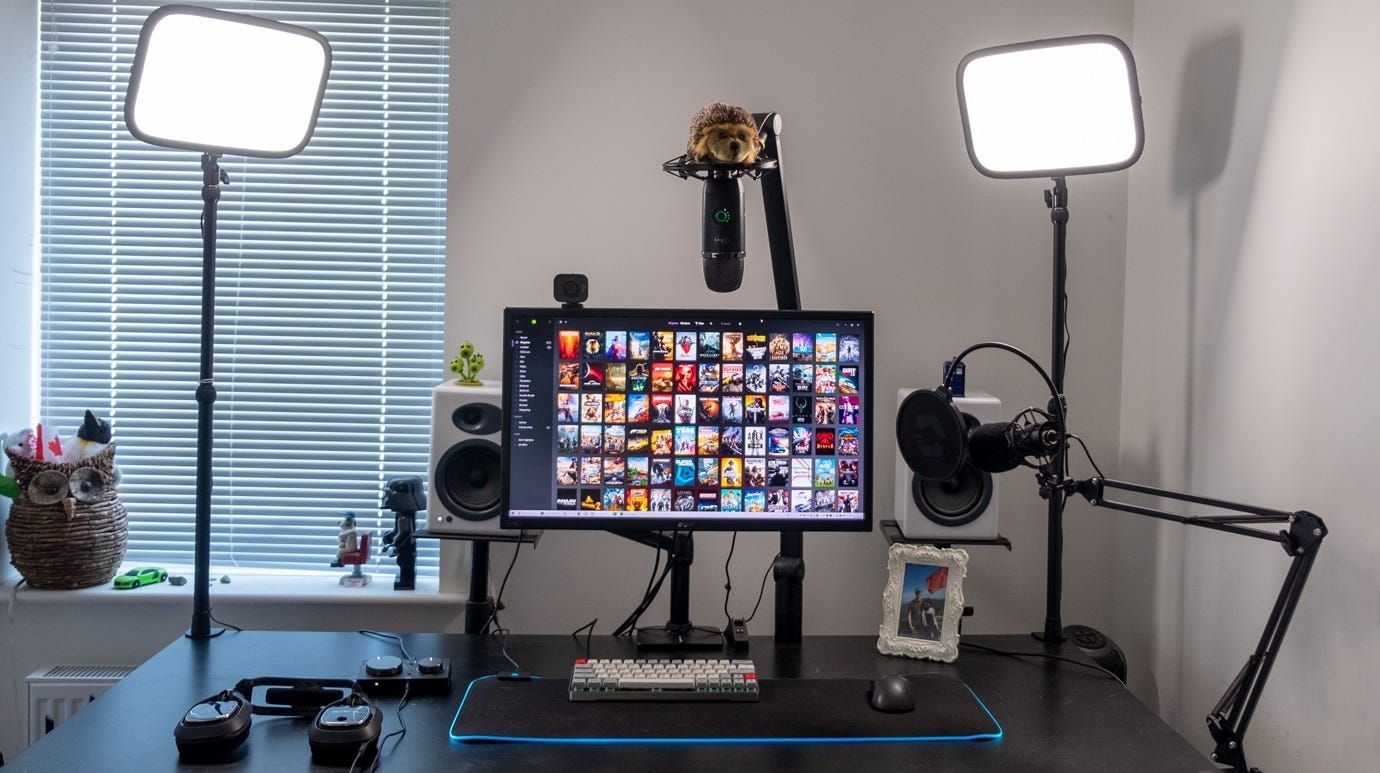
If you're streaming games on Twitch, YouTube or inded anywhere else, you'll want to make sure you look and sound your best. This article rounds up our recommendations for the mics, webcams and lighting you can use to make that happen, from cheap budget options for when you're just getting started to more high-end kit that can take your stream to the next level.
If you're hunting around for the best streaming equipment on Twitch, then our guide rounds up the best mics, lights and cameras you can buy right now to craft the perfect setup.
Best mics, lights and cameras for streaming
- Joby Wavo Pod - Best cheap USB mic
- 512 Audio Tempest - Best budget USB mic
- PreSonus Revelator - Best USB mic for streaming
- Logitech Yeti GX - Best dynamic USB mic for streaming
- Audio-Technica AT2020 - Best cheap XLR mic for streaming
- Rode Procaster or Shure SM7B - Best XLR mics for streaming
- Rode RodeCaster Duo - Best audio interface for streaming
- Elgato Facecam 4K - Best camera for streaming
- Elgato Facecam Neo - Best value camera for streaming
- Obsbot Meet 2 - Best camera for laptops
- Elgato Key Light - Best lighting for streaming
- Logitech Litra Beam LX - Most capable lighting for streaming
- Elgato Key Light Neo - Best value lighting for streaming
- Elgato Stream Deck Neo - Best value controls for streaming
Best cheap USB mic: Joby Wavo PodLudicrously cheap for what you get |
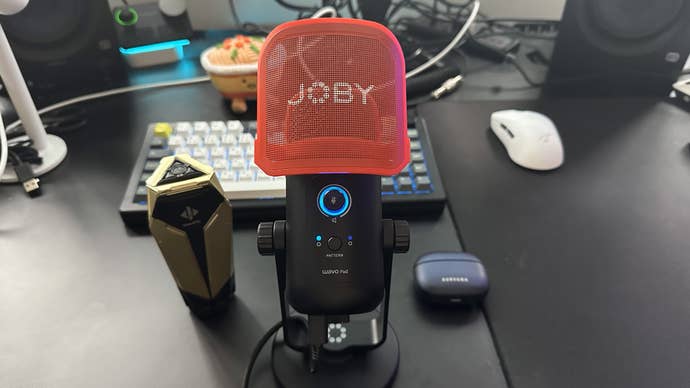
The Joby Wavo Pod is a microphone that is so cheap that I'm genuinely confused how its manufacturers, best known for their tripods, are making money. Somehow, despite retailing for not much over £20/$20, it hits all of our basic requirements for streaming, with an included stand (and boom arm compatibility), a 3.5mm jack for live monitoring, a multi-function dial and a simple USB-C connection with plug-and-play compatibility on Windows and Mac alike.
There are even multiple polar patterns, with cardioid and bi-directional modes, allowing for a bit of unexpected flexibility, and the included pop filter is also reasonably effective at rejecting plosives.
Given the price, it's hard to argue against at least giving this a try and seeing if it's sufficient for your needs - I'm guessing that a lot of people will be fully satisfied for less than the cost of a meal out.
- Pro: Acceptable audio quality with two pickup patterns
- Pro: Good controls with live monitoring via 3.5mm
- Con: Plastic construction, though the pop filter is a nice inclusion
Best budget USB mic: 512 Audio TempestSimple and effective, with one minor flaw |

The 512 Audio Tempest was once a premium offering, but is now widely available in the US at a budget price - often under $50. That is a tremendous price for a USB condenser microphone that captures a huge amount of detail and includes on-body controls and live monitoring via 3.5mm. That makes it a much better choice than our previous pick, the relatively basic £50/$40 Blue Snowball Ice.
The Tempest is well-constructed, with a metal body, and comes with a shock mount and a relatively simple desk stand. You'll probably want to upgrade this for a fixed setup - to reclaim desk space, position it more in front of your mouth and prevent the mic picking up every tap on your keyboard - but it's surprisingly stable given the weight of the microphone, if a little short.
The only annoyance with the Tempest is a blue LED at the top of the unit, which can't be turned off. Thankfully, you can turn the mic around to avoid it, though you of course lose access to the mute, gain and headphone volume controls. There's also only one pickup pattern, unlike more expensive mics which typically come with multiple options to suit a wider range of circumstances - but for a single person talking in a room, this is more than fine.
- Pro: Excellent audio quality for the money
- Pro: Plug-and-play USB operation with on-board controls
- Con: Always-on blue LED is a bummer, and seems to only be discounted in the US
Best USB mic for streaming: PreSonus RevelatorDetailed audio, excellent software, now cheaper |

- Pro: Detailed audio quality with multiple recording patterns
- Pro: Excellent software, with useful presets and loopback controls
- Con: Built-in stand is functional, but budget for a boom arm
The PreSonus Revelator is a strong option that records detailed sound and has three recording patterns to choose from, but with a more professional appearance than most gaming-focused options and more comprehensive controls too. The inclusion of a 3.5mm headphone jack is handy, as it means you can plug in headphones to monitor exactly what the mic is hearing, and there are also buttons on the front to turn on monitoring and toggle between different presets, each with their own associated colour. The included stand is well-built and stable but a little short, so for best results you'll want to use a mount of some kind.
The software here is outstanding, and together with the built-in DSP, sets this mic apart. Selecting and modifying different effects is straightforward and you can hear the results live, making it easier to dial in the right sound. The built-in presets are generally good right out of the box, and there are eight more 'slots' for your own custom profiles. The Universal Control app also includes loopback controls - very handy for getting audio in and out of various programs, whether you're serenading your teammates with karaoke in multiplayer games or streaming to Twitch without the need for a hardware mixer.
If you like to really play with those knobs, the Revelator is worth the extra investment.
Best dynamic USB mic for streaming: Logitech Yeti GXAn affordable dynamic mic with Logitech backing |
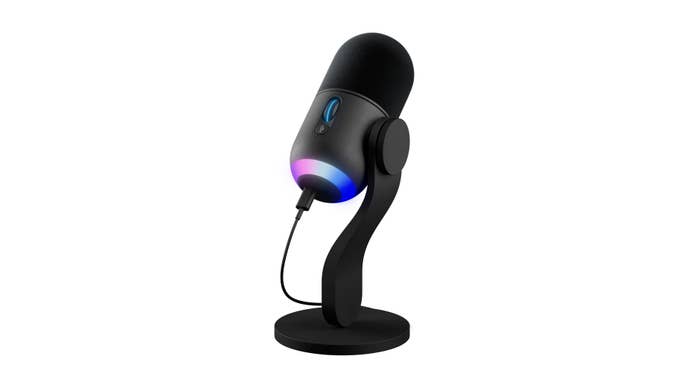
Logitech's first post-Blue Yeti gaming microphone is the Yeti GX, a snub-nosed and compact USB-C dynamic mic. Like other dynamic options, this is a good choice for use in noisy environments with background noise, with the supercardioid pattern honing in your voice and rejecting the clatter or keyboards or distant conversations. The audio quality here isn't top-notch, perhaps due to the size of the unit, but the modest dimensions do make the mic easy to position while the RGB lighting on the tail stands out on stream.
Gain is set via a Logitech mouse scroll wheel embedded on one side, with lighting that indicates on (white), active (green) and clipping (flashing red); unfortunately there's no live monitoring here. Instead, you'll use the Smart Audio Lock feature, clicking in the wheel (blue) to automatically maintain the current level. Blue branding lives on in Blue Voice presets via the G Hub software, which are worth experimenting with but not essential. There's also a sampler feature here, which features preset phrases in various languages - though I did note that the Chinese sample labelled "Hello" (你好) was actually "How are you?" (你好吗), which is odd.
Overall, a capable microphone, but not one that's able to capture as much detail as our condenser picks above - so choose accordingly.
- Pro: Easy USB-C connection without the need for G Hub software
- Pro: Cute and compact design with RGB lighting
- Con: Lacks some detail vs condenser mics, though off-axis rejection is useful
Best cheap XLR mic for streaming: Audio-Technica AT2020A warm, professional-looking entry to the XLR ecosystem |
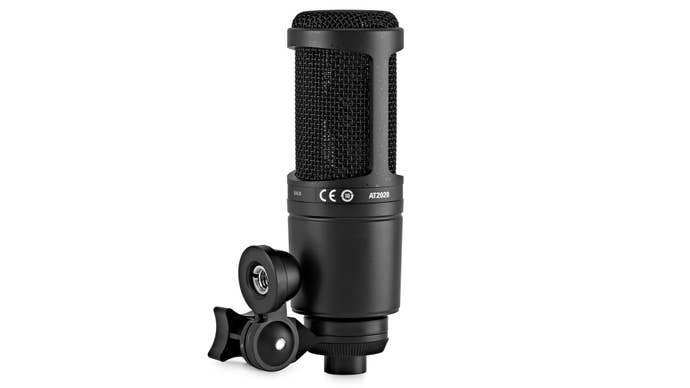
The Audio-Technica AT2020 is a popular entry-level XLR condenser mic, offering the possibility of extremely clear audio if you're willing to put together the necessary equipment to get it running. All that comes in the box is the mic, a bag and a stand adapter, so you'll need to provide at least an XLR cable, a stand and an audio interface or mixer that provides at least 48V of phantom power. Once all of these components are in place, your reward is warm, detailed audio that works well for streaming or voice-over work.
- Pro: Warm, precise sound
- Pro: Professional, almost anonymous appearance
- Con: Requires extra kit to get started, but XLR accessories can be powerful
Best XLR mics for streaming: Rode Procaster or Shure SM7BTwo premiere options from gold-standard names |
|

If you're willing to spend more, there are better XLR microphones available too. The two we're recommending are both dynamic microphones, which are better equipped to isolate your voice compared to condenser mics. This is great for streaming games, as it means background audio like the clatter of your keyboard or your housemates won't be audible on stream.
The first is the Rode Procaster, which includes a built-in pop shield and provides very clean audio, particularly when the mic is placed just a few inches from your mouth. The Procaster normally comes with just the microphone itself and is relatively heavy, so consider picking up a good boom arm (like Rode's excellent PSA1) to ensure it stays in that perfect pick-up location.
Our second recommendation is for the Shure SM7B. This legendary microphone is used by audio professionals of all stripes, including recording artists and radio hosts, and of course it's a favourite of streamers as well. The quality here is top notch, and you can come close to the mic for a warmer tone if you like.
The SM7B does require a fair amount of gain, so choosing a top audio interface is important - or opting for the more expensive SM7DB (see prices on Amazon UK / US). This upgraded model comes with a built-in preamp so it works well with a wider range of interfaces.
- Pro: Professional-grade audio quality with proximity effect
- Pro: Dynamic microphones mean less unwanted background noise
- Con: Requires some set-up, including audio interface and boom arms
Best audio interface for streaming: Rode RodeCaster DuoPowerful, well-supported audio production |
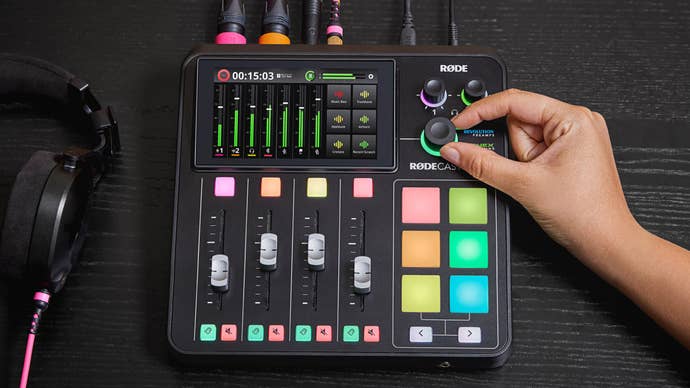
The Rode RodeCaster Duo is an incredibly powerful all-in-one audio interface for streamers and content creators of all kinds, offering 48V of phantom power to XLR microphones and up to 76dB of gain to drive pretty much all mics on the market. While the RodeCaster doesn't come cheap, the convenience of the hardware controls like faders, buttons and knobs on this unit is substantial. Combined with the system performance benefits of accomplishing your mixing and routing via hardware rather than software, and you're left with a convincing package.
The impressive audio hardware and controls are backed up by a powerful - and even somewhat intuitive - software package that allows microphones to be dialled in and various processing to be done to keep your voice sounding just the way you want it - and unlike the GoXLR we recommended before, it's still under active development. You can also adjust how audio is routed to any of the unit's multiple USB audio devices. For example, you can set your game to one audio device, your mic to another, your chat to another and so on.
While the RodeCaster Duo takes up less desk space than some of its more professionally-minded mixers and audio interfaces, it is still a sizable bit of kit - so mull whether you'll make use all of its functionality and consider something like the FocusRite Scarlett (£80/$100) or Elgato Wave XLR (£140/$160) if you just want to connect an easy-to-drive XLR mic to your PC with minimal controls.
- Pro: Powerful all-in-one audio interface and mixing solution with built-in display
- Pro: Convenient assortment of ports, faders and buttons
- Con: Not insubstantial asking price or footprint
Best camera for streaming: Elgato Facecam 4KA chonky webcam with great optics, filters and smart software |
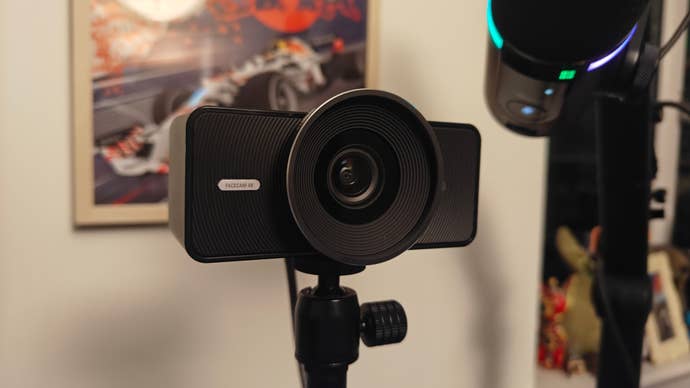
While big name streamers tend to use high-end mirrorless, DSLR or even action cameras to record video, often hooked up via a Cam Link or similar, USB webcams offer a much easier way for Twitch streamers to get started. The ideal option offers high-end video quality with intuitive software and no extra hardware required.
The best option we've tested is the Elgato Facecam 4K, the latest in a line of streaming-focused webcams that uses a seven-element prime lens and a large Starvis 2 CMOS sensor to provide excellent image quality without the potential for autofocus hunting issues.
The Facecam 4K delivers a 4K 60fps image (via MJPEG, or uncompressed 4K 30fps NV12) with a 90-degree field of view, providing plenty of latitude for zooming, subject tracking and so on. These controls and many more can be found in Camera Hub app, allowing fine-grained control over the exposure, white balance, noise reduction, saturation, sharpness and so on. These variables can all be saved to the camera itself, so if you move it to a new PC it'll remember how it was set up before, no software required. The Facecam 4K also supports "HDR" at up to 4K 30fps, which effectively boosts brightness in exchange for halving the frame-rate. In terms of privacy, there's a blue light when the camera is on and a lens cap. Finally, 49mm filter compatibility allow you to customise your look or prevent glare.
There are some drawbacks to be aware of too. Elgato is targeting professional streamers with this camera, so there's no built-in microphone. This makes sense - standalone mics sound much better and not including one here saves space and cost - but it's easy to forget it doesn't have one. The Facecam 4K also requires a USB 3.0 connection for maximum quality, though it does at least function on USB 2.0 ports. And even at full bandwidth, the camera isn't quite as adept at drawing out details in low light as the bigger lens found in the $100 more expensive Facecam Pro, which remains Corsair's top-end option.
From a value proposition, the Facecam 4K ranks as one the best webcams I've ever tested, as it brings most of the exceptional image quality and smart feature set of the Facecam Pro while costing two thirds of the price.
- Pro: Excellent image quality with a fixed focus lens
- Pro: Smart, intuitive software and 49mm filters allow creative tweaks
- Con: No mic, and not quite as good-looking as the more premium Facecam Pro
Best value camera for streaming: Elgato Facecam NeoSmaller, cheaper and good enough |
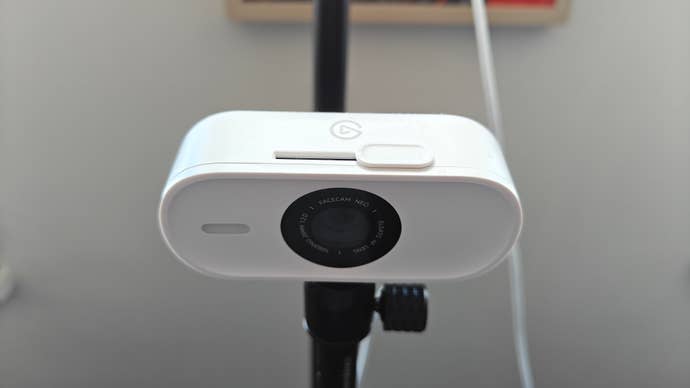
A cheaper alternative is the Elgato Facecam Neo. This 1080p60 camera hovers around less than half the price of the Elgato Facecam MK.2, and still delivers good results. The picture out of the box is good, with natural colours and appropriate exposure, but it looks obviously less sharp and less saturated than the full-fat Facecam. The autofocus is OK, sometimes hunting unnecessarily, but there's also the option for a fixed focus if you prefer. Low light performance here is another weakness, so a setup with natural light or one of the light recommendations below will result in a much better and more consistent image.
There are plenty of controls available in the Camera Hub software to make the best of things, including zooming and face tracking, automatic or manual focus, contrast, saturation, sharpness, exposure, white balance (w/ LUTs) and noise reduction. You can save various presets and switch between them quickly too.
In terms of mounting, you can use the provided monitor mount to attach the webcam to a monitor or laptop - it even comes with a transparent front portion to ensure it doesn't block any slim-bezel screens - or use the screw mount for a more professional solution. The small size and low weight makes it easy to position. There's also a slider to physically block the webcam's view, and there's no microphone so that isn't a security concern either.
All things considered, the Facecam Neo is a well designed webcam that provides arguably better value than the full-fat Facecam, with less fussy USB requirements and an easier mounting experience. However, it does fall short in terms of image quality and software customisability, so either option could make sense depending on your priorities.
- Pro: Provides clear video at 1080p60 and mounts easily
- Pro: Works out of the box, but powerful Camera Hub software also available
- Con: No built-in mic, for better and for worse
Best camera for laptops: Obsbot Meet 2Extraordinarily tiny, but still effective |
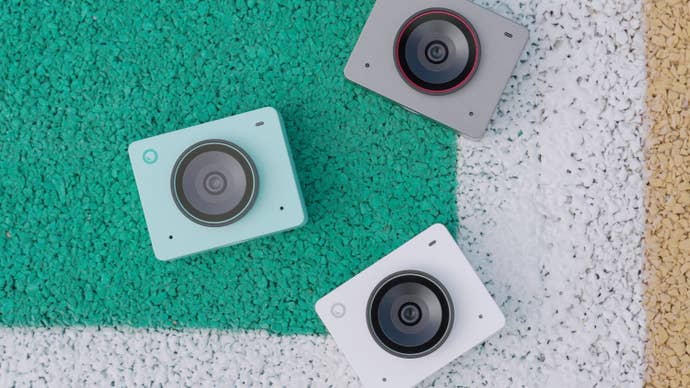
The Obsbot Meet 2 is an intriguing 4K camera with an incredibly small frame and both magnetic and screw mounting options, making it a good choice for laptops or as a secondary camera - perhaps one focusing on your keyboard or mouse in gaming streams. Whatever you use it for, you benefit from reliable and rapidly evolving software, including good automatic subject tracking and framing, though you do miss out on the gimbal-mounted possibilities of the also-great Tiny 2.
The half-inch sensor delivers easily passable results, though physics dictates that larger webcams will generally offer better detail and particularly low-light performance. A microphone is also included, though it's not much better than that built into most laptops these days. Still, what's here is impressive, especially at a kerb weight of just 40 grams, and the price is right.
- Pro: Extremely small and reasonably affordable for a 4K-capable camera
- Pro: Magnetic and traditional quarter-inch screw mount, multiple colours
- Con: Image quality doesn't compare to larger glass
Best lighting for streaming: Elgato Key LightEasy to mount, easy to control, professional results |

- Pro: Control via PC/mobile apps plus StreamDeck integration
- Pro: Easy to mount and install
- Con: You're paying a premium for temperature control and convenience
When the first game streamers started on the early version of Twitch, they tended to use bulky fluorescent lights and softboxes for professional-looking lighting - at the expense of huge heat output. Today, LEDs can provide that same healthy glow without the accompanying heat stroke, with panel lights offering the most convenient and compact setup. Here, the Elgato Key Light is an excellent choice. These lights are a little larger than a sheet of paper and provide up to 2800 lumens, which can be adjusted from a warm 2900K to clinical 7000K.
Setup is a cinch too, with the lights clamping onto the side of your desk, telescoping out to the desired height and tilting to find the perfect angle. From here, you can connect to the lights via Wi-Fi (2.4GHz only) and control them in their own software or from an Elgato Stream Deck Mini. The Elgato Key Light is relatively expensive, especially if you pick up a pair, but being able to adjust your lighting from your desktop makes the premium feel worthwhile.
Most capable lighting for streaming: Logitech Litra Beam LXAll-in-one key lighting and ambient RGB |
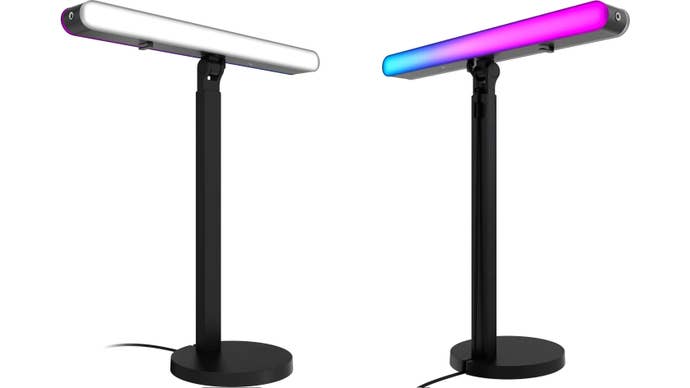
Logitech's Litra Beam LX is a powerful dual-sided tube-style light, providing key lighting with adjustable colour temperature and brightness on one side and adjustable RGB ambient lighting on the other. It can be controlled via Bluetooth or USB connections, with core functions additionally mapped to physical buttons, giving you plenty of options. However, the Beam LX must be powered via a wall outlet, unlike its predecessor, the Litra Beam, which could get away with USB power (albeit at reduced brightness).
On PC, the G Hub software includes a wide range of lighting settings, including a 'screen sampler' mode that provides true ambient lighting for whatever is on screen; you also get the option to enable the forwards-facing light only when a camera is active.
The Litra Beam LX's focus on flexibility also extends to its positioning. The default desk stand can be attached to either end or the middle of the light, allowing for vertical or horizontal placement, with further height and angle adjustment to make positioning straightforward. One-quarter-inch screw fittings mean that you can use a wide range of other mounts if you prefer; I found the default stand took up a bit too much desk space when I positioned the light directly behind the screen, but a simple desk mount improved things - and there are specific VESA mounts that would have been even better.
This is a nice all-in-one solution that handles both key and ambient lighting, with a good degree of flexibility and sensible software to tie it all together. The key lighting is bright and complimentary too, while the RGB lighting has sufficient LEDs to produce some pleasingly gradual gradients between colours. That means it's worth its premium price for professional streamers and content creators, and will be worth considering for a wider range of users as its price goes down over time.
- Pro: Key lighting on one side, ambient RGB lighting on the reverse
- Pro: Control via Bluetooth, USB or physical buttons
- Con: Default stand can be hard to place, though other mounting options exist
Best value lighting for streaming: Elgato Key Light NeoSmall but effective lighting at a discount |
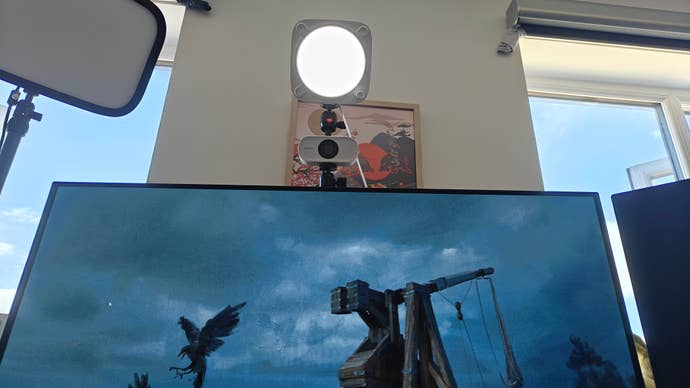
If you're after something smaller, more portable and less expensive than our first two options, than the Elgato Key Light Neo could be a good choice. This small circular LED in a squircle frame clips onto your monitor like a webcam, runs off USB power and includes convenient physical controls in each corner so you don't need an app to control its basic functions. For a more professional tripod or arm mount, you can also remove the monitor clip and instead use a standard 1/4-inch screw thread. A 100cm/40in cable and 150cm/60in extension are also provided to give you extra flexibility in terms of powering the light.
The Key Light Neo can be set up to 1000 lumens at 100 percent brightness and colour temperature can be adjusted between 2700K and 6500K, so you have options for warmer or more clinical lighting. You also have the option for app control from PC with the Elgato Control Center app, but the light has to be connected over USB - where it's limited to a (still impressive) 400 lumens. Overall, it's a solid little package for the money and a great choice if you want something a little easier to work with than a massive Key Light.
- Pro: The Key Light Neo is small, but still provides a good amount of diffuse light
- Pro: The USB-powered design with physical controls is convenient to use
- Con: Need to connect to USB power adapter for max 1000 lumen output
Best value controls for streaming: Elgato Stream Deck NeoEight LCD buttons, a handy date/time widget and excellent integration |
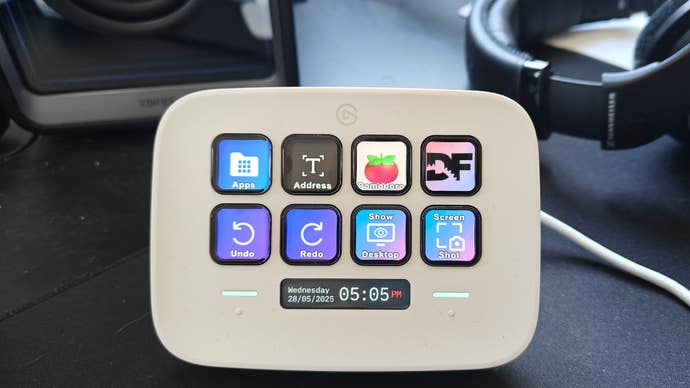
The Elgato Stream Deck Neo is a powerful, relatively affordable for triggering scene changes, controlling your volume and otherwise granting you easy access to whatever you need while streaming, without the need to alt-tab out of games or find a specific window running on your computer. Setting up each button is very easy, with good preset options as well as extensive customisability, and you can easily set up multiple pages or deep menus to access as many functions as you'd ever need.
The Neo in particular comes with a second display area, a strip along the bottom of the screen that can show the time and date or other information, which I like quite a bit. There are also dedicated page change buttons on either side of this display, allowing you access other pages without using up one of your eight buttons.
Unsurprisingly, the Stream Deck offers tight integration with other Elgato products, like lights, cameras and microphones, making it sometimes more effective to stick with this single manufacturer rather than choosing items wholesale. However, the Stream Deck can still be pretty useful even if it's your first/only Elgato product.
- Pro: Convenient form factor with eight easily readable LCD buttons, plus time display and page change buttons
- Pro: Well-designed software makes it easy to set up the Stream Deck with useful actions
- Con: Requires other Elgato peripherals to hit its maximum potential
Frequently asked questions
What PC hardware do I need for streaming?
Generally speaking, modern PCs can handle the extra demands of streaming pretty well, thanks to hardware media encoders found on modern Nvidia and AMD graphics cards and the prevalence of high core count CPUs. If you can run your favourite game at a good frame-rate and you have a modern gaming PC, streaming shouldn't introduce much overhead.
In terms of processors, we recommend a modern Ryzen 5000, 7000 or 9000-series CPU if you're building a PC from scratch for playing and streaming, as the extra cores that Ryzen provides are very useful and pair well with inexpensive motherboards. Intel's 12th-gen parts onwards also tend to perform well and can be paired with DDR4 or DDR5 motherboards, though the latter is a better choice now that prices have fallen. For graphics cards, NVENC on RTX cards is still the premiere option, but AMD's RDNA 4 graphics cards (such as the RX 9070 and 9070 XT onwards) make significant strides in terms of quality and features.
Otherwise, the speed of your internet connection will limit the bitrate, resolution and frame-rate you can stream at. It's worth connecting your computer directly to your router via an ethernet cable rather than using wireless to get the most out of your connection, especially if you have high-speed fibre broadband. As with most things, spend some time testing your internet connection speed and stability, and consider upgrading if you're not able to stream in at least 720p at 30fps - with 1080p at 60fps being the ideal.
What's the most important accessory for streaming?
We'd say that good-quality audio is the most important, assuming you're spending most of your stream time in-game. After audio is sorted, consider upgrading to a mid-range webcam and adding lights if necessary. A second monitor, stream controls (like the Elgato Stream Deck or Corsair K95 Platinum XT keyboard) and a capture card from the likes of Avermedia or Elgato can also be helpful.
For that second monitor, we recommend a value-oriented option - something that is 1080p and 60fps will work just fine. If you have a decent budget for this, then an IPS screen with wide viewing angles works nicely, and larger screens with higher resolutions will give you more screen real estate to put your chat window, video preview window and other controls.
What microphone accessories are useful?
There are a range of accessories we could discuss, but the most important for newcomers are boom arms and pop filters. Rather than relying on the short stands included with many USB and XLR microphones, a proper adjustable arm makes it easier to position your microphone so that it picks up your voice without taking up too much of your screen (if you're playing a game) or your camera's point of view (if you're streaming). When adjusting your arm, take your microphone's style of address into account.
Side-address microphones, like the Blue Yeti, work best when you're speaking into one side, while top address microphones should be pointed directly at your mouth. We used a Blue Compass arm and Radius 3 shock mount for testing these microphones, but there are many other options available at a range of price points.
Pop filters and wind shields are the next accessory you should consider, as they reduce the impact of plosives - sounds like p and b that are harsh on the ears if they are recorded by a bare microphone. Pop filters and wind shields are normally mounted onto your mic or boom arm, and need to be positioned between you and your mic to be effective.
For XLR mics, you'll also need an audio interface (like the GoXLR mentioned above or the Focusrite Scarlett linked below) and an XLR male to female cable to hook up your microphone.
Is it better to use USB or XLR?
If you're just going to use your single mic at your PC, then a USB microphone is ideal - it's plug and play, with no extra equipment needed. XLR mics need to be connected via an audio interface, but these allow you to include other audio equipment like multiple microphones or mixers. If you're just starting out, USB is the way to go, while XLR may be a better choice for dedicated content creators that want room to grow into more advanced setups. You can also split the difference - pick up an XLR mic, but use a simple XLR to USB adapter until you bring in a proper audio interface.
You didn't cover product or topic X?
Whoops, we must have missed it - or perhaps there just wasn't the space to include it here. Feel free to leave product recommendations or questions in the comments below, or reach out to us on Twitter @wsjudd for a better response rate.
